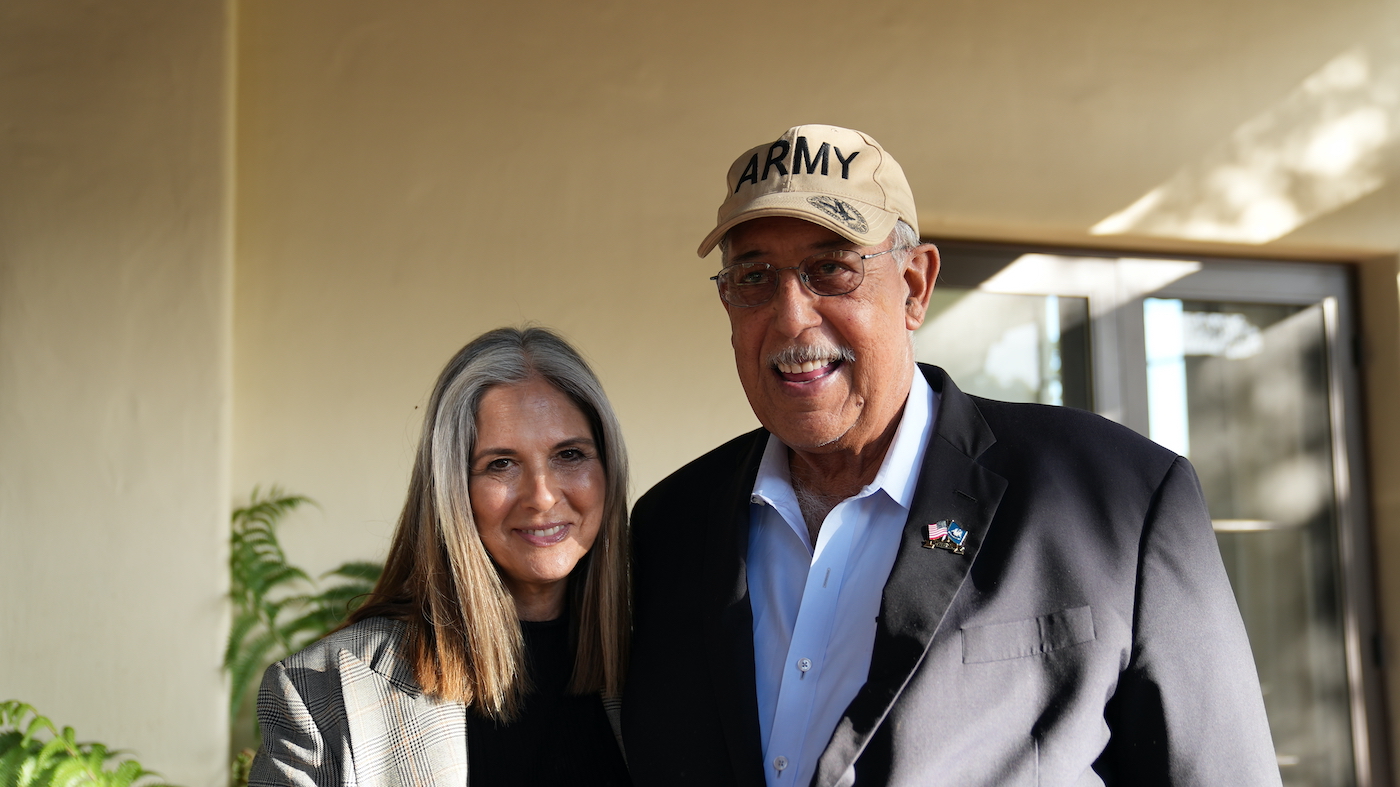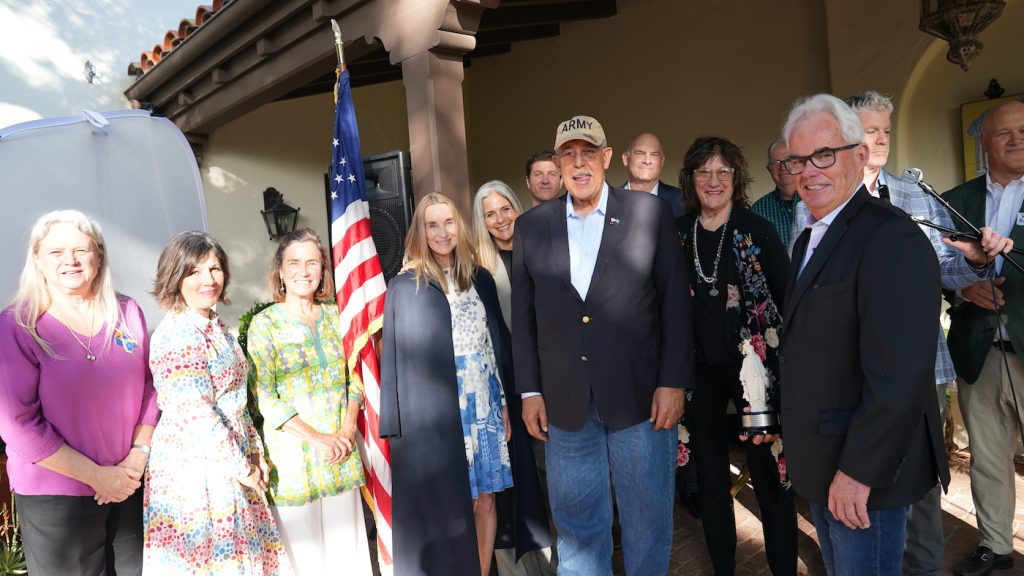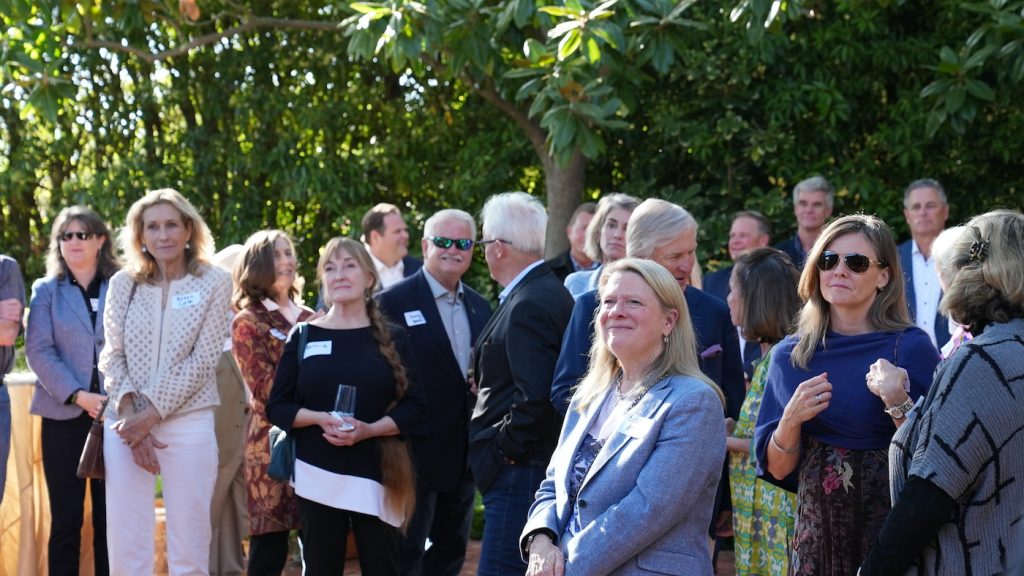TPRC Wins National Award for Ring Net Project But Work to Shield Montecito from Future Disaster Has Only Begun

In a bittersweet ceremony, Montecito’s The Project for Resilient Communities (TPRC) on Sunday received a prestigious national award for the private-public project that installed protective ring nets in canyons where deadly torrents surged down in the 1/9 disaster.
Three leaders of the Virginia-based ReadyCommunities Partnership, which spotlights and supports efforts across the nation demonstrating “resiliency through innovation” in the face of local calamities, traveled here to bestow the award to 12 leaders of the Montecito group. TPRC was borne of the tragic and staggering debris flow of January 9, 2018, which claimed 23 lives, destroyed hundreds of homes, and caused $1 billion in damage.
Formally presenting the award was retired Lt. General Russel L. Honoré, an iconic figure among first responders, who commanded relief efforts in New Orleans following Hurricane Katrina and, more recently, led an investigation into the performance of the U.S. Capitol police during last year’s insurrection in Washington.
“You all have set an example for the nation, for the state, and for the region,” said General Honoré, speaking to about 40 guests gathered under an azure sky on the terrace of the home of Ginger Salazar and Brett Matthews. “You had an ‘Aha moment’ that changed your lives – and you did something about it,” he added.
For leaders of the local 501(c)3 nonprofit, the event was less a culmination of their volunteer labors in the years since the 2018 catastrophe, than a pivot to a far more ambitious strategy. With a new research study in hand, the group now seeks a collaboration with county government – to develop and implement a “master plan,” offering protection from life-threatening flood waters, brimming with huge boulders and tons of other debris, that have coursed down the Santa Ynez Mountains for centuries.
Reflecting that long-range perspective, Gen. Honoré in his remarks not only praised the work to date of the Montecito partnership – but also pointed to the future, cautioning that events like 1/9 are part of a “new normal,” as the ravages of climate change worsen, inflicting more destructive and more unpredictable disasters on communities and countries around the globe. “The new normal is about adaptation,” he said. “The future we feared is already here.”
Another speaker at Sunday’s event was Dr. Rosalie J. Wyatt, National Director of the ReadyCommunities organization. She expressed the heartache, just below the surface of the low-key celebration, as she fought back tears in speaking of the 23 victims of the disaster, and led the audience in a moment of silence to honor them. “You had a vision for saving future lives,” she said to those receiving the award. “Leaders at the local level are the ones who see a need and fill it.”
The award itself is a small replica of the Statue of Freedom, which tops the Capitol, made of marble taken during a construction project from the steps of the historic building that houses Congress. Accepting the award on behalf of the group was Pat McElroy, the former Santa Barbara fire chief, whose commitment, energy, and perseverance helped drive the nets project. Also cited from the TPRC research, permitting implementation, and fundraising team: Joe Cole, Suzanne Elledge, Les Firestein, Elisabeth Fowler, Hillary Hauser, Hollye Jacobs, Brett Matthews, Alixe Mattingly, Bruce McRoy, Mary Rose, Damon Taugher, and Gwyn Lurie, editor in chief of the Montecito Journal. “A lot of us didn’t have a choice,” McElroy said. “We needed to be involved if we were going to heal.”
The Ring Story

The story behind the partnership’s accomplishment of so much so swiftly is a tale worthy of a book. It began just days after the disaster, when Cole, Lurie, and Matthews had an impromptu conversation in the cafeteria of Cottage Hospital, where they’d come to check on neighbors injured in the debris flow; soon they began drafting others to help address a simple, terrifying fact: the conditions that triggered the disaster – mountain surfaces denuded of all vegetation by the recent Thomas Fire – posed the urgent threat of another disaster in Montecito, for at least the next five years. “The true north of the project was to make the mountain safer,” Lurie recalled in an interview. “We wanted to find a way, concretely, to make the community more resilient.”
Throughout, McElroy remembered, the group was guided by a comment first made by Jacobs, and soon taken up by others, that they were on their own in the critical enterprise: “Hollye said, ‘There is no cavalry coming,’” he recalled. “There was no bandwidth for the county to do it,” amid the exigencies of dealing with the immediate aftermath of the disaster. “The community needed to step up and help the government.”
Those who committed to the project brought an array of skills aligned with the countless challenges – financial, political, engineering, for starters – the group faced. “When we needed expertise, someone would pop up,” said McElroy. For example, Firestein comprehensively researched ways and means to “hold mountains up,” recalled Lurie, his spouse, and after considerable fact-finding, recommended a Swiss company called Geobrugg, which manufactured strong steel rings used to prevent avalanches.
Installing them, however, required a raft of permits – from the U.S. Army Corps of Engineers, the State Water Resources Control Board, and California’s Department of Fish and Wildlife – not to mention the county, where District 1 Supervisor Das Williams later would pull together a unanimous vote of his colleagues backing the project. Elledge, one of the county’s premier planning consultants, convened the full array of stakeholders at a meeting at Montecito Fire Protection District headquarters to identify issues of concern, while Rose used her deep political consulting experience in shaping the approach to government agencies and elected officials.
Much of the committee’s work focused on fundraising: they collected $5 million in 18 months, from over 1,000 donors, with contributions that ranged from $10 to $500,000 (including $20,000 that came in after McElroy and Firestein made an appearance on the Ellen show). The Santa Barbara Foundation guaranteed the $1 million required as a condition of permits, and Montecito Bank & Trust administered the bond.
Contractors were identified and hired to craft each net individually for each site, and eventually six were installed in locations linked to the loss of life: Cold Spring, San Ysidro, Buena Vista. “We were doing a proof of concept,” McElroy said. “Nobody had ever installed these in endangered species areas.” After installation, and five-year emergency permits, the partnership made all of its work product available – free of charge – to any community anywhere that faces similar peril. “Anybody who wants it, gets it,” the former fire chief added. The looming threat. While laudable, the net project is only the first, relatively small part of what leaders of the Partnership hope to achieve.
Echoing Gen. Honoré’s warnings about the future, they are embarking on the broader mission of developing a master plan to manage flood waters amid the complex and dangerous terrain above Montecito, and its alluvial flood plain. To begin, the group commissioned and funded what, astonishingly, is the first comprehensive study of the history of local events such as 1/9.
The Looming Threat

Titled “Fire, Flood and Landslide Dam History: The Community of Montecito and Vicinity,” the 166-page study is researched and written by Dr. Larry Gurrola, an engineering geologist based in Ventura, and Dr. J. David Rogers, professor of Geological Engineering at the Missouri University of Science and Technology. TRPC hopes the report will form the foundation for a county master plan for Montecito and its surroundings. A review of the study shows there is much to be done. In the immediate wake of the 2018 disaster, for example, it was common to hear the claim that the disaster was “a 1,000-year event” or a “500-year event” and therefore unlikely to reoccur in the near future. In fact, it was far from rare.
In reviewing the geological record and journalistic history of the area, the authors learned that 1/9, in fact, was the fifth such event of extreme magnitude in the past 200 years; previous massive debris flows occurred in 1861, 1895, 1914, and 1995. The maximum time between such events has been 81 years, the minimum 23, for an average of one every 40 years. In addition, the study detailed dozens more flood and debris flow events of somewhat less magnitude during the same period. The majority, like 1/9, followed major wildfires. “The historical inventory recognized a much greater frequency of destructive debris flows and debris laden flood events than previously assumed,” the scientists wrote.
In a conversation at Sunday’s event, Gurrola said that the current network of flood control work to protect Montecito – even including the new steel nets and the county’s in-progress Randall Road debris basin – is an “almost patchwork” line of prevention that is “orders of magnitude” less than what is needed to safeguard the community from a future 1/9. Some key excerpts from the Gurrola-Rogers study:
“The debris flow hazard remains high for significant portions of the community, including homes located along the Cold Spring, Hot Springs, and Montecito Creek corridors… The total capacity of the two debris basins and two debris nets in the Montecito Creek watershed is roughly 45,500 yards.
“However, estimates of the total volume of debris discharged from the Cold Spring and Hot Springs creeks watersheds exceeds 300,000 yards [according to] the U.S. Geological Survey [in 2019] and is estimated by [a 2021 scientific study] to be greater than 400,000 yards, which is nearly 10-fold greater than the capacity of the basins and nets combined.” (Emphasis ours.)
“Considering the new understanding of the frequency of damaging debris flows established in this flood inventory, together with estimate of the total debris volume produced in the 1/9 event,” the authors conclude, “the determination that the existing debris basins are insufficient for mitigation of moderate to large debris flows is without question… Development of a master plan study and strategizing the components of mitigation and alternative solutions is recommended.”
McElroy makes the point in somewhat more colorful language: “We are going to have more big-ass fires; we are going to have more big-ass floods. It’s going to continue happening because it’s always happening. The nets were the first step, but without a master plan, it’s just a reaction plan,” he added. “You’ve got to keep awareness high. The work isn’t done.”
Jerry Roberts has worked in the news business as a reporter, editor, columnist, commentator, and author for nearly 50 years







